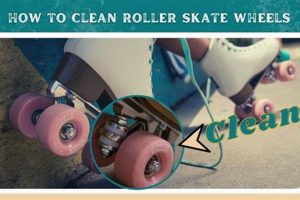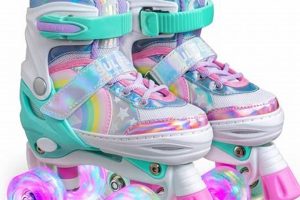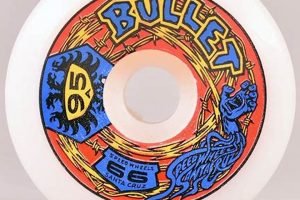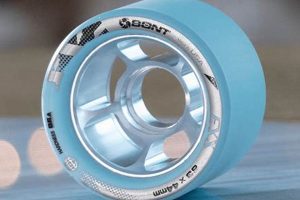Components facilitating motion on inline roller skates, these circular objects directly contact the skating surface. Generally constructed from polyurethane, they are mounted in a linear arrangement along the skate frame. Their properties, such as size, hardness, and profile, influence skating speed, grip, and maneuverability. For example, larger diameters typically result in faster speeds, while softer durometers enhance grip.
The selection and maintenance of these components are critical to the overall skating experience. Correct choices optimize performance, ensuring efficient energy transfer and control. Historically, variations in material composition and design have led to significant advancements in the sport, allowing for specialized uses ranging from recreational skating to aggressive inline and speed skating. The durability and longevity of the chosen components impact the lifespan of the skates themselves, making them a worthwhile consideration.
The following sections will delve into the specific characteristics of these circular components, examining the factors that influence their selection, usage, and maintenance. This will include discussions on durometer ratings, bearing compatibility, frame types, and relevant replacement procedures for optimal performance and safety.
Inline Roller Skates Wheels
Maximizing the potential of inline skates necessitates careful attention to the selection, maintenance, and appropriate use of its circular components. These tips aim to provide guidance in achieving optimal performance and extending the lifespan of these vital elements.
Tip 1: Select the Appropriate Durometer. Durometer, measured on the A scale, indicates the hardness of the material. Softer examples (74A-82A) provide superior grip but wear more quickly, suitable for recreational skating. Harder options (84A-90A+) offer increased speed and durability, ideal for experienced skaters and smoother surfaces.
Tip 2: Match the Diameter to the Skating Style. Larger diameters generally equate to faster speeds but reduced maneuverability. Smaller diameters offer enhanced control. Speed skating often utilizes larger sizes (100mm+), while aggressive skating favors smaller, more robust options (55mm-72mm).
Tip 3: Inspect for Wear Regularly. Uneven wear patterns can indicate alignment issues or improper technique. Rotating the placements periodically distributes wear and extends their lifespan. Replace those exhibiting significant wear or damage to maintain consistent performance and safety.
Tip 4: Maintain Bearing Cleanliness. Bearings affect the rolling efficiency of the circular component. Periodic cleaning and lubrication of the bearings is crucial. Remove debris and dirt with a solvent, followed by re-lubrication with a bearing-specific oil or grease.
Tip 5: Use on Appropriate Surfaces. Abrasive surfaces accelerate wear. Seek smoother surfaces whenever possible to prolong their lifespan. Avoid skating on surfaces with excessive debris, as this can damage the rolling components.
Tip 6: Ensure Proper Alignment. Misaligned frames or axles can cause uneven wear and reduced performance. Regularly inspect and adjust the frame alignment to ensure that they are perpendicular to the skating surface.
Tip 7: Store Skates Properly. Store skates in a cool, dry environment away from direct sunlight. Exposure to extreme temperatures or humidity can degrade the polyurethane material.
By adhering to these guidelines, skaters can significantly enhance the performance, safety, and longevity of their equipment. Selecting the correct type, practicing regular maintenance, and utilizing proper techniques are all crucial components in optimizing the skating experience.
The subsequent sections will elaborate on specific applications and considerations for various skating disciplines, further refining the understanding and application of these concepts.
1. Durometer (hardness)
The durometer rating of inline roller skates’ circular components quantifies their hardness, a critical factor influencing performance and application. Measured using the Shore A scale, this rating dictates the material’s resistance to indentation. A lower durometer signifies a softer composition, offering increased grip and shock absorption. This is particularly advantageous on rough surfaces or for skating styles demanding enhanced control, such as recreational skating or fitness workouts. For instance, a durometer of 78A to 82A would provide a comfortable ride and improved traction for a beginner skater.
Conversely, a higher durometer denotes a harder composition, which reduces rolling resistance and maximizes speed. Such harder options, typically ranging from 84A to 90A and above, are favoured in speed skating and on smoother, more controlled surfaces like skate parks. This allows skaters to achieve higher velocities with less energy expenditure. The relationship between durometer and wear is also significant; softer options tend to wear down more quickly than their harder counterparts due to increased friction with the skating surface. Therefore, the selection of appropriate hardness involves balancing the desired level of grip, speed, and component lifespan.
The practical significance of understanding durometer lies in optimizing the skating experience. Choosing a durometer that aligns with the skater’s skill level, skating style, and the prevalent skating environment enhances both performance and safety. Inappropriate durometer selection can lead to compromised grip, reduced speed, or premature wear, thereby impacting the overall effectiveness and enjoyment of the activity. Therefore, informed consideration of durometer is paramount when purchasing or replacing the circular rolling elements of inline skates.
2. Diameter (size)
Diameter, measured in millimeters (mm), represents a crucial characteristic defining inline roller skates’ circular components. Its selection directly influences speed, maneuverability, and the overall skating experience. Different skating disciplines demand varying diameter ranges to optimize performance.
- Speed and Rolling Efficiency
Larger diameters generally result in greater rolling efficiency. A larger diameter covers more ground per revolution, leading to higher potential speeds. This is particularly advantageous in speed skating and long-distance skating where minimizing resistance is paramount. For instance, speed skaters commonly utilize diameters exceeding 100mm, sometimes up to 125mm or larger. This increased diameter provides a distinct speed advantage on smooth surfaces.
- Maneuverability and Agility
Conversely, smaller diameters enhance maneuverability and agility. Smaller examples allow for quicker turns and tighter control, making them suitable for aggressive skating, hockey, and recreational skating where responsiveness is more critical than top speed. Aggressive skaters typically employ diameters ranging from 55mm to 72mm, enabling them to perform complex tricks and navigate obstacles with greater ease.
- Acceleration and Responsiveness
Smaller diameter options tend to exhibit faster acceleration compared to larger diameters. This is due to the reduced rotational inertia, allowing for quicker changes in speed. This is beneficial in scenarios requiring rapid starts and stops, such as urban skating or hockey, where immediate responsiveness is crucial for navigating dynamic environments and reacting to changing situations on the rink.
- Frame Compatibility and Limitations
The frame of the inline skates dictates the maximum diameter that can be accommodated. Exceeding the frame’s capacity can lead to component damage or hinder performance. It is therefore essential to select diameters that are compatible with the skate frame. Frame manufacturers typically specify the maximum size, ensuring proper clearance and optimal functionality.
The selection of an appropriate diameter is a critical consideration when choosing replacement circular components. Skaters must carefully evaluate their skating style, the intended skating environment, and the frame compatibility to ensure optimal performance and safety. The correct diameter can significantly enhance the overall skating experience, maximizing enjoyment and efficiency.
3. Profile (shape)
The profile, or shape, of inline roller skates wheels significantly influences their performance characteristics. The profile refers to the cross-sectional curvature of the rolling surface and affects contact area, grip, and rolling resistance. A rounder profile, for example, promotes smoother turning and greater maneuverability, as it allows for progressive engagement of the edge during leans. A flatter profile, conversely, maximizes contact area, enhancing grip and straight-line speed. The selection of a specific profile directly impacts the skater’s control, agility, and speed capabilities. For instance, hockey wheels often feature a rounded profile to facilitate quick turns and agile movements, while speed skating wheels may adopt a flatter profile to optimize straight-line velocity.
The practical significance of understanding profile lies in tailoring equipment to specific skating styles and surface conditions. A skater who primarily engages in recreational skating on varied terrain might benefit from a moderately rounded profile that balances maneuverability and speed. An aggressive skater executing intricate tricks and grinds will likely prefer a more rounded profile for increased control and responsiveness. Consideration of surface quality is also critical; smoother surfaces may accommodate flatter profiles for enhanced speed, while rougher surfaces might necessitate rounder profiles for improved grip and shock absorption. Maintenance and replacement must also account for profile wear, as uneven wear can compromise performance and handling. Consistent rotation and timely replacement of components are essential to maintain optimal skating characteristics.
In summary, the profile of inline roller skates wheels represents a critical design element impacting skating performance. Its influence on contact area, grip, and rolling resistance makes it a primary determinant of speed, maneuverability, and overall control. Awareness of the profile characteristics and their relationship to skating styles and surface conditions empowers skaters to make informed equipment choices, enhancing their experience and maximizing their potential. Understanding the interconnectedness between profile, durometer, and diameter contributes to a holistic appreciation of wheel functionality and its impact on skating performance.
4. Bearing Compatibility
Bearing compatibility represents a critical, often overlooked, aspect of selecting and maintaining inline roller skates wheels. Bearings facilitate the smooth rotation of the wheel around the axle, and their proper integration with the wheel’s hub is essential for optimal performance and safety. Incompatibility can lead to diminished rolling efficiency, premature wear, and even catastrophic failure.
- Standard Bearing Size (608)
The vast majority of inline roller skates wheels are designed to accommodate the standardized 608 bearing. This designation refers to a bearing with an 8mm inner diameter, 22mm outer diameter, and 7mm width. Wheels engineered for 608 bearings typically feature a recessed hub designed to precisely house the bearing, ensuring a secure and aligned fit. Deviations from this standard are rare but must be accounted for to prevent damage to the wheel or bearing.
- Mini Bearings (688)
While less common in standard inline skates, mini bearings (688) with a smaller profile are sometimes used, particularly in specialized applications or older skate designs. These bearings feature a smaller outer diameter than 608 bearings and require wheels specifically designed to accommodate their reduced size. Attempting to install standard 608 bearings in a wheel designed for 688 bearings, or vice versa, will result in improper fit and compromised performance.
- Bearing Seat Precision
The precision of the bearing seat within the wheel hub directly impacts bearing performance and longevity. An improperly machined or damaged bearing seat can cause misalignment, leading to increased friction, accelerated wear, and reduced speed. Inspecting the bearing seat for imperfections, such as cracks or deformities, is crucial prior to installing new bearings. High-quality wheels often feature tighter tolerances in their bearing seats, ensuring a more secure and precise fit.
- Bearing Spacers and Alignment
Bearing spacers, typically made of metal or plastic, are inserted between the two bearings within a single wheel. Their purpose is to maintain proper alignment and prevent the bearings from being over-tightened when the axle nut is tightened. Using the correct spacers ensures even distribution of pressure across the bearing surfaces, reducing friction and extending bearing life. Absence of spacers, or use of incorrect spacers, can result in premature bearing failure and reduced wheel performance.
The correct selection and installation of bearings are paramount to the optimal performance and lifespan of inline roller skates wheels. Ensuring compatibility in terms of size, bearing seat precision, and the use of appropriate spacers will contribute to a smoother, faster, and safer skating experience. Neglecting these aspects can lead to diminished performance, increased maintenance requirements, and potentially hazardous skating conditions.
5. Material Composition
The material composition of inline roller skates wheels directly dictates their performance characteristics, durability, and suitability for various skating styles and surfaces. The selection of materials impacts properties such as grip, rebound, wear resistance, and overall rolling efficiency, making it a critical factor in wheel design and selection.
- Polyurethane (PU) Formulation
Polyurethane is the predominant material used in the manufacture of inline roller skates wheels. The specific formulation of the PU compound significantly influences the wheel’s durometer (hardness), rebound (elasticity), and abrasion resistance. High-rebound PU formulations enhance energy return with each stride, leading to increased speed and reduced fatigue. Varying the PU formulation allows manufacturers to tailor wheel properties to specific skating disciplines, such as speed skating, recreational skating, or aggressive skating.
- Core Material and Design
The core, or hub, of the wheel, typically constructed from rigid materials like nylon or polycarbonate, provides structural support and houses the bearings. The design and material of the core impact the wheel’s overall stiffness and ability to transfer energy efficiently. A stiffer core enhances power transfer, particularly at higher speeds, while a more flexible core can improve shock absorption and comfort. Some high-performance wheels incorporate complex core designs, such as spoked or hollow cores, to minimize weight and optimize performance characteristics.
- Additives and Fillers
Manufacturers often incorporate additives and fillers into the PU compound to further modify wheel properties. These additives can include pigments for coloration, UV stabilizers to prevent degradation from sunlight exposure, and various fillers to enhance abrasion resistance or alter the wheel’s damping characteristics. The type and concentration of these additives are carefully controlled to achieve desired performance attributes without compromising the wheel’s structural integrity.
- Bonding and Lamination Techniques
The process by which the PU tire is bonded to the core is crucial for ensuring the wheel’s structural integrity and preventing delamination. Advanced bonding techniques, such as chemical bonding or mechanical interlocking, create a strong and durable interface between the tire and core. Multi-layer lamination processes can also be employed to optimize the distribution of material properties, such as combining a high-rebound outer layer with a more durable inner layer.
In summary, the material composition of inline roller skates wheels is a complex interplay of PU formulation, core material, additives, and bonding techniques. These factors collectively determine the wheel’s performance characteristics and suitability for various skating applications. Careful consideration of these material aspects is essential for skaters seeking to optimize their performance and enjoyment of the sport.
Frequently Asked Questions
The following addresses common inquiries concerning inline roller skates wheels, their properties, maintenance, and selection criteria. This information aims to clarify aspects of their functionality and optimal utilization.
Question 1: What does the durometer rating signify for inline roller skates wheels?
The durometer rating, measured on the Shore A scale, indicates the hardness of the wheel’s polyurethane material. Lower numbers denote softer wheels with increased grip and shock absorption, while higher numbers represent harder wheels with greater speed and durability.
Question 2: How does wheel diameter influence skating performance?
Wheel diameter directly impacts speed and maneuverability. Larger diameters generally facilitate higher speeds due to increased rolling efficiency, while smaller diameters enhance agility and responsiveness.
Question 3: What is the significance of the wheel profile?
The wheel profile, or shape, affects contact area and rolling characteristics. A rounder profile allows for smoother turns, while a flatter profile maximizes contact area for increased grip and straight-line speed.
Question 4: How frequently should inline roller skates wheels be rotated?
Rotation frequency depends on skating style and surface conditions. Regular rotation, typically after every few skating sessions, helps to distribute wear evenly and prolong wheel lifespan. Uneven wear patterns indicate the need for more frequent rotation.
Question 5: What are the key considerations when selecting replacement wheels?
Key considerations include durometer, diameter, profile, bearing compatibility, and intended skating environment. Selecting wheels that align with the skater’s skill level, skating style, and typical skating surfaces is crucial for optimal performance and safety.
Question 6: How does bearing maintenance impact wheel performance?
Clean and lubricated bearings ensure smooth wheel rotation and efficient energy transfer. Regular cleaning and lubrication of bearings are essential to maintain optimal performance and extend bearing lifespan. Contaminated or dry bearings can significantly reduce rolling efficiency and increase wear.
Proper understanding of these factors ensures informed decision-making when selecting, maintaining, and utilizing inline roller skates wheels. Optimizing these components directly enhances the skating experience.
The subsequent section will provide a comprehensive guide to troubleshooting common wheel-related issues.
Inline Roller Skates Wheels
This exposition has detailed the multifaceted aspects of inline roller skates wheels, encompassing material composition, durometer, diameter, profile, and bearing compatibility. Each element contributes significantly to the overall skating experience. Appropriate selection and diligent maintenance are demonstrably critical for optimal performance, safety, and longevity.
The principles outlined herein should inform skaters’ choices, fostering a deeper understanding of the interplay between equipment and technique. Continued advancement in materials science and manufacturing processes promises further refinement of these circular components, ensuring sustained evolution in the realm of inline skating. Skaters are encouraged to review regularly, for the quality of their equipment safety, efficiency, and pleasure of this sport.







